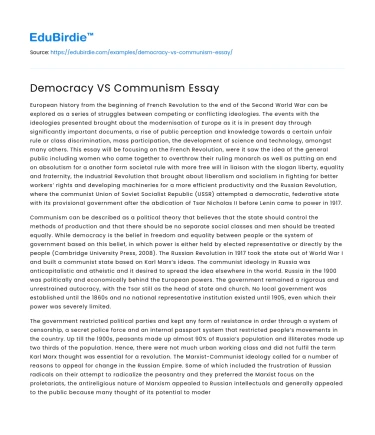European history from the beginning of French Revolution to the end of the Second World War can be explored as a series of struggles between competing or conflicting ideologies. The events with the ideologies presented brought about the modernisation of Europe as it is in present day through significantly important documents, a rise of public perception and knowledge towards a certain unfair rule or class discrimination, mass participation, the development of science and technology, amongst many others. This essay will be focusing on the French Revolution, were it saw the idea of the general public including women who came together to overthrow their ruling monarch as well as putting an end on absolutism for a another form societal rule with more free will in liaison with the slogan liberty, equality and fraternity, the Industrial Revolution that brought about liberalism and socialism in fighting for better workers’ rights and developing machineries for a more efficient productivity and the Russian Revolution, where the communist Union of Soviet Socialist Republic (USSR) attempted a democratic, federative state with its provisional government after the abdication of Tsar Nicholas II before Lenin came to power in 1917.
Communism can be described as a political theory that believes that the state should control the methods of production and that there should be no separate social classes and men should be treated equally. While democracy is the belief in freedom and equality between people or the system of government based on this belief, in which power is either held by elected representative or directly by the people (Cambridge University Press, 2008). The Russian Revolution in 1917 took the state out of World War I and built a communist state based on Karl Marx’s ideas. The communist ideology in Russia was anticapitalistic and atheistic and it desired to spread the idea elsewhere in the world. Russia in the 1900 was politically and economically behind the European powers. The government remained a rigorous and unrestrained autocracy, with the Tsar still as the head of state and church. No local government was established until the 1860s and no national representative institution existed until 1905, even which their power was severely limited.
Save your time!
We can take care of your essay
- Proper editing and formatting
- Free revision, title page, and bibliography
- Flexible prices and money-back guarantee
The government restricted political parties and kept any form of resistance in order through a system of censorship, a secret police force and an internal passport system that restricted people’s movements in the country. Up till the 1900s, peasants made up almost 90% of Russia’s population and illiterates made up two thirds of the population. Hence, there were not much urban working class and did not fulfil the term Karl Marx thought was essential for a revolution. The Marxist-Communist ideology called for a number of reasons to appeal for change in the Russian Empire. Some of which included the frustration of Russian radicals on their attempt to radicalize the peasantry and they preferred the Marxist focus on the proletariats, the antireligious nature of Marxism appealed to Russian intellectuals and generally appealed to the public because many thought of its potential to modernize Russia.
Marxist theory was also assisted in understanding Russia’s backwardness as part of its development in history. Russian radicals living outside Russia formed the Marxist Social Democratic Labour Party in 1898. There were split along two strands, the Bolsheviks led by Vladimir Lenin that pushed for an immediate revolution and Mensheviks led by Julius Martov that argued for a more gradual approach (Cavendish, 2003). By the start of 1917, the over 14 million peasants’ soldiers in the military were undersupplied, which led to the shortages of food. In March that year, riots and demonstration for bread begun and Tsar Nicholas II, ruler at the time was forced to abdicate. A mock government that was set up by the Duma sworn to form a constitutional government and hold free elections. On the other hand, soldiers and workers had came up with their own governing bodies called the soviets which are also known as councils. Each council are responsible to their electors and are bound by their instructions and the elected candidates are only responsible to their conscience.
Moreover, the elected candidates can be dismissed at any time which reflected the idea of democracy. The Bolshevik took over some function in the city’s administration and subsequently challenged the mock government through the Petrograd Soviet. When Lenin return from exile in April the same year, he rallied the Bolshevik and confronted the mock government. Lenin quickly consolidated to power and occupied the Winter Palace with the dismissal of the mock government with no bloodshed. In 1918, Tsar Nicholas II and his family were executed by the Bolsheviks in fear of the tsar serving as a rally point during the civil war. (Lindemann 2013; Mason 2015)
In conclusion, the competing ideologies successfully led to the modernisation of Europe, through demonstration, strikes with some form of bloodshed involved. Nonetheless, it impacted the history of Europe with a series of economic and political instability and more crucially, some form of adjustments in the governing of the state. These ideologies through history had brought people together such as the bourgeoisie and the proletariats to stand up for a certain agenda. The French Revolution, Industrial Revolution and Russian Revolution all have their own significance and have lasting impact on the constitutions of the state in the present day by laying its foundations and spreading of the ideology across the globe many years ago.






 Stuck on your essay?
Stuck on your essay?

